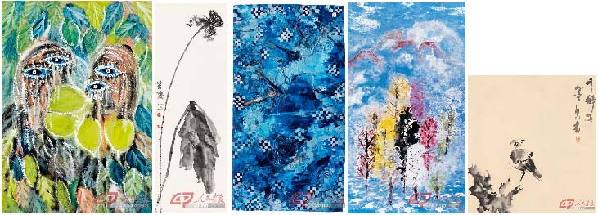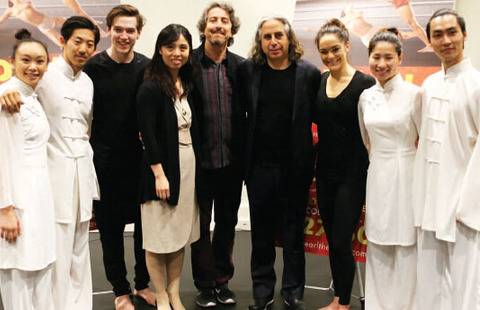Xu Dongdong: Chinese abstract painting goes global
Updated: 2015-07-29 12:27
(China Pictorial)
|
||||||||
 |
|
No.1, Souls of Creatures in Four Seasons series, acrylic on paper, 179×384cm, 2013-2014 |
Early summer of 2015 brought Beijing landscapes dotted with lush plants and flowers. Just after sitting down, Xu Dongdong reveals Souls of Creatures in Four Seasons, his latest series of paintings which was just completed a few months ago. Viewed from afar, the series leaves a similar impression to Western abstract paintings. However, a closer look shows that the paintings are full of Chinese elements. Using acrylic as pigment, the paint was applied to rubbed Chinese rice paper, which is moistened before receiving coats of paint to create a singular image.
Xu's interview with China Pictorial marked his first media interview since he left the public eye more than a decade ago. The interview began with a look at his Chinese abstract paintings. As a pioneer, Xu hopes to construct an open artistic system for Chinese paintings to move from traditional to modern, and from regional to international.

Young Star
Xu was born in 1959 to a Beijing family of scholars. He fell in love with painting as a kid. "Although I was tutored by many teachers, I started to learn traditional Chinese painting by imitating works of Chinese masters from various dynasties," he recalls. In the 1970s, the Palace Museum, also known as the Forbidden City, dried its collected paintings in batches in natural conditions every year. The move brought greater opportunities for various exhibitions. Xu, then a teenager, visited almost every exhibition to study great works from ancient masters, and often stayed at the museum for a whole day.
Of various categories of traditional Chinese painting such as figures, landscapes, and flowers and birds, the gifted young man was drawn to landscapes the most. In the 1980s, Xu set off on a special pilgrimage to various Chinese mountains. "Quite different from Western landscape paintings, Chinese landscape paintings embody special Chinese worship and admiration of mountains," Xu asserts. In the years that followed, Xu travelled to almost every renowned Chinese mountain and great body of water. During the process, not only did his painting skills develop rapidly, but he learned "how ancient Chinese sages observed and communicated with nature" and began to explore the relationship between man and nature.
His painting career progressed smoothly. In 1986, the album Xu Dongdong's Collection of Poems and Paintings was published. Liu Kaiqu, then curator of National Art Museum of China, wrote an article praising Xu as "a painter with distinctive features and great talent." In 1987, a solo exhibition of Xu's work was held in the main hall of the National Art Museum of China and his works were collected by the museum, making him the youngest artist ever to hold a marquee solo exhibition at the museum. In 1988, Xu was bestowed the title of national grade-I artist (professor), and became a member of the China Artists Association the next year, another rare feat in China's painting circles at that time. The young man's work became highly acclaimed.
As the honors piled up, Xu increasingly felt that painting was part of the process to achieve harmony between man and nature. Greatly influenced by Neo-Confucianism from the Song (960-1279) and Ming (1368-1644) dynasties, Xu proposed the artistic idea of "infinite universal consciousness." He emphasized that painters must "create artistic concepts with soul and spirit," setting a solid foundation for the formation of his own world view in the days to come.

 World's largest radio telescope being built
World's largest radio telescope being built Elvis Festival pays tribute to the King of Rock 'n' Roll
Elvis Festival pays tribute to the King of Rock 'n' Roll
 Four-color rice turns paddy field into artwork
Four-color rice turns paddy field into artwork
 Images capture modern life of a warrior monk
Images capture modern life of a warrior monk
 The world in photos: July 20 - 26
The world in photos: July 20 - 26
 Amazing landscape of China in white and black
Amazing landscape of China in white and black
 Across America over the week (July 17- July 23)
Across America over the week (July 17- July 23)
 Unusual but true: 'Love' conquers all
Unusual but true: 'Love' conquers all
Most Viewed
Editor's Picks

|

|

|

|

|

|
Today's Top News
Beijing condemns Somali attack, mourns deaths
Panda 'fakes pregnancy' to get better living conditions
China eyes deepened cooperation with overseas NGOs
Monster Hunt breaks Chinese box office record
Olympic bid panel cites city's merits
Astronomers discover most Earth-like planet yet
Seattle Chinatown leader killed in shooting
Flight details of Obama's Kenya trip leaked
US Weekly

|

|







